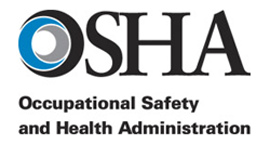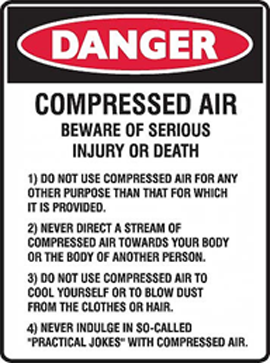Dangers Of Compressed Air

Is it a good idea to use compressed air to remove dust from clothing, components or work surfaces?
Considering the dangers of compressed air, it is not a good idea to use compressed air to fulfil these tasks. Although many people know using compressed air to clean clothes can be hazardous, it is still used because of old habits and the easy availability of compressed air in many workplaces.
Most compressed air applications are not connected to electricity, so people do not always consider what dangers may be lurking. But just as safety regulations must be observed for electrical machines and tools, compressed air components must also be treated with respect to avoid dangerous accidents.

“Very serious injuries, sometimes fatal, have occurred when the nozzle of the gun has been pointed towards the body, even at some distance from it. Many of the injuries occur when clothing is dusted down and because of this compressed air should never be used for cleaning clothing. Others are the result of horseplay.”
Extract taken from Health and Safety Executive – HSG39
Is cleaning with compressed air allowed by law?
In some parts of the World (such as regions within Canada), cleaning with compressed air is not allowed by law. However, more and more companies are realising the dangers posed by compressed air for blow-off, and now issue cautionary statements within their own company work rules which may result in written warnings or indeed more seriously dismissal.

OSHA
In the United States workplace safety is regulated by OSHA regulations. OSHA is the acronym for Occupational Safety and Health Administration. Compressed air use is governed by 1910.242.b, which says that air pressure in direct contact with the skin cannot exceed 210 kPa (30 psi).
The use of protective air cones is generally accepted to protect the operator, but barriers, baffles or screens may be necessary to protect employees from being exposed to flying chips or particles. ACI’s JetBlack is designed to meet these safety requirements.
https://www.osha.gov/
Exactly what are the hazards for blow-off?
Compressed air is a concentrated stream of air at high pressure and high speed that can cause serious injury to the operator and the people around him. First, compressed air is itself is a serious hazard. It has been known for compressed air to enter the blood stream through a break in the skin or through a body opening. An air bubble in the blood stream is known medically as an embolism, a dangerous medical condition in which a blood vessel is blocked, in this case, by an air bubble.
An embolism of an artery can cause coma, paralysis or death depending upon its size, duration and location. While air embolisms are usually associated with incorrect scuba-diving procedures, they are possible with compressed air due to high pressures. This may all seem to be improbable, but the consequences of even a small quantity of air or other gas in the blood can quickly be fatal so it needs to be taken seriously.
Unfortunately, horseplay has been a cause of some serious workplace accidents caused by individuals not aware of the hazards of compressed air, or proper work procedures.

- Compressed air accidentally blown into the mouth can rupture the lungs, stomach or intestines
- Compressed air can enter the navel, even through a layer of clothing, and inflate and rupture the intestines
- Compressed air can enter the bloodstream, and death is possible if it makes its way to blood vessels in the brain
- Direct contact with compressed air can lead to serious medical conditions and even death
- Even safety nozzles which regulate compressed air pressure below 30 psi should not be used to clean the human body
- As little as 12 pounds of compressed air pressure can blow an eye out of its socket. If an air pocket reaches the heart, it causes symptoms similar to a heart attack. Upon reaching the brain, pockets of air may lead to a stroke.
What should I use instead of compressed air for cleaning purposes?
The JetBlack Safety range are a safe alternative to compressed air, using less energy and emitting less noise than compressed air units. The blower-driven systems delivers a high volume of air at a relatively low pressure – only 2.52 PSI (200 mBar), well below OSHA requirements for North America.
The lower pressure means the units can be safely aimed at virtually any part of the body (except eyes and ears); even direct contact with skin poses no hazard (it is still recommend to exercise caution when using any machinery).
If the airborne dust being removed is harmful, then JetBlack Safety also offers a full body cleaning booth which has the ability to remove and collect the dust safely and efficiently.
Cleaning Booths
JetBlack Safety Cleaning Booths are self-contained, de-dusting systems which easily remove, extract and collect dust and debris from the clothes and body.
“Compressed air is dangerous – in fact it can kill. When we initially suggested a safer, dedicated dust blow-off booth for cleaning clothing people here thought we were mad! However, a few months after the booth was installed everyone now uses it on a regular basis and it is accepted throughout the entire company.”
Craig Bunn, Health and Safety Manager for the RNLI







